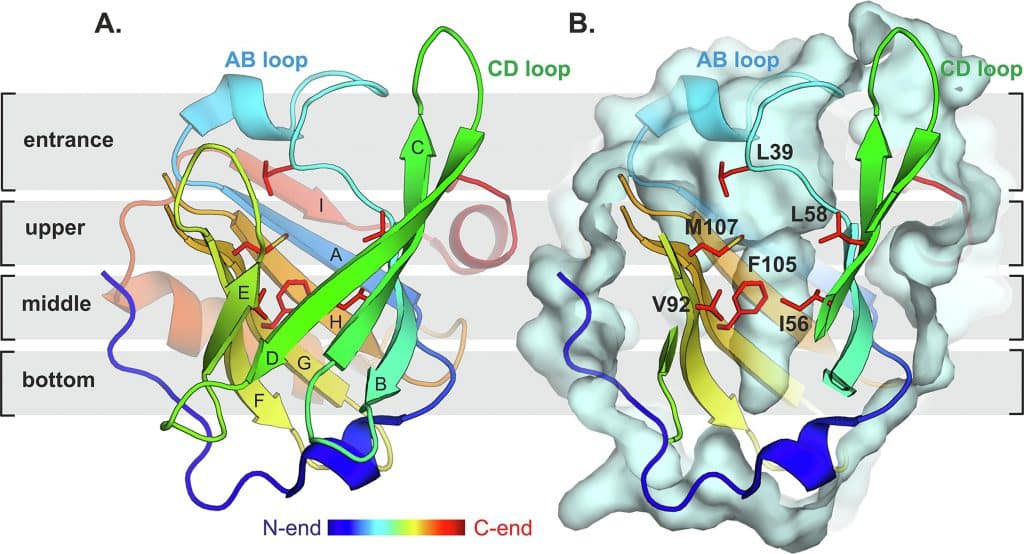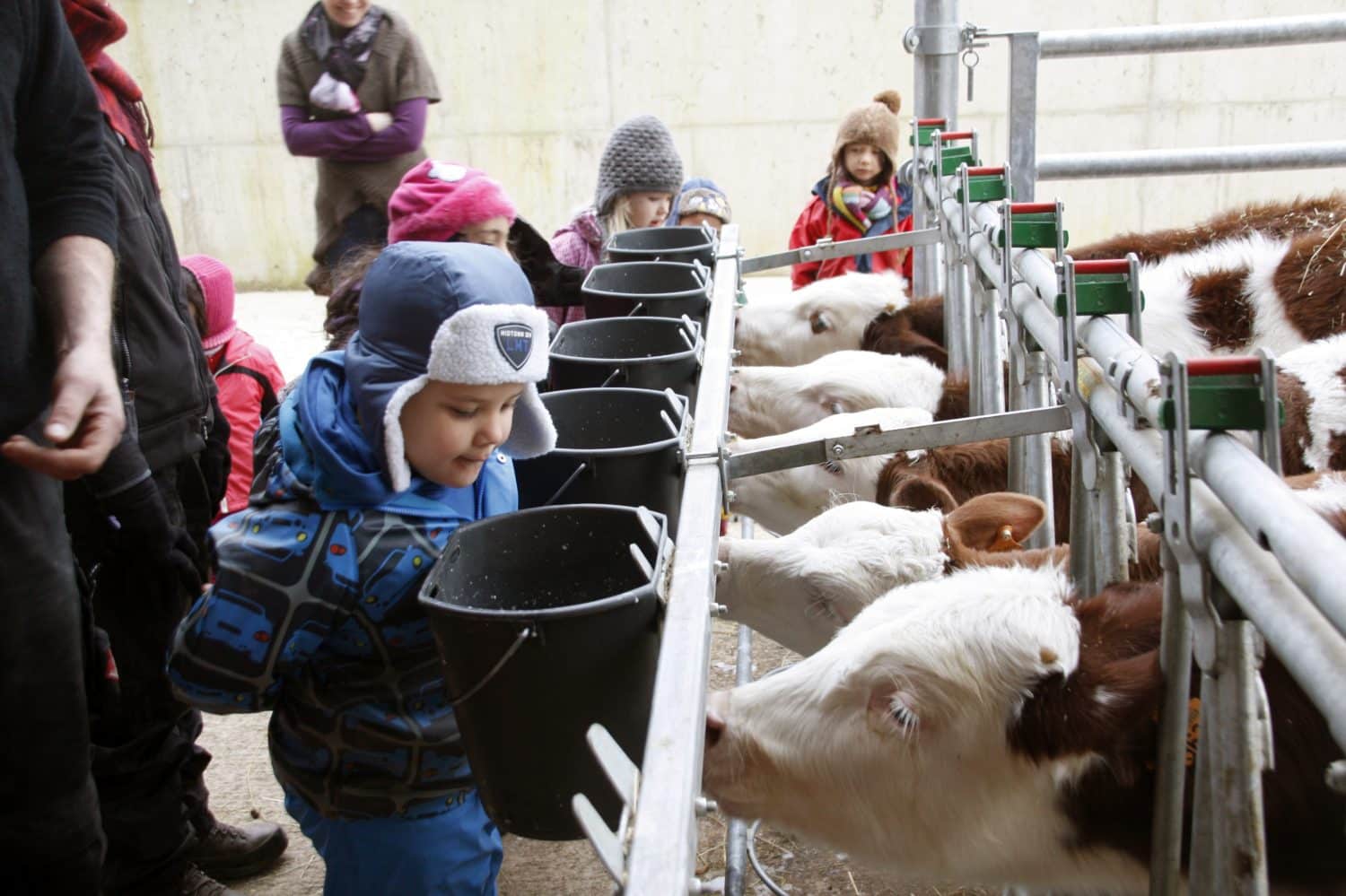Take home message
- Chelates of beta-lactoglobulin (BLG) are formed when various substances, such as iron, vitamin A or polyphenols, bind to the BLG. This is called the holo form of the BLG. Holo-BLG has an anti-inflammatory and immune-suppressing effect in contrast to the alo form or heated BLG.
- This form of holo-BLG has been included in the cowshed pill, with which it is possible to reduce asthma in patients by 40-60%.
Raw milk, cow sheds, pregnant mothers and babies
As early as 2001, researchers (Riedler et al., 2001) discovered that raw milk consumption had a protective effect on asthma, allergy and hay fever in children. The study was performed with farm women who may or may not be working in the barn during their pregnancy. There were therefore good comparisons to be made between (see Table 1):
- Pregnant farm women, who did or did not work in the barn (daily or non-daily)
- Pregnant farm women, who may or may not drink raw farm milk during their pregnancy (results not shown)
- Their babies, who were or were not taken into the stable when mother was working in the stable
- Their babies, who may or may not receive raw farm milk, often before the first year of life (FM <1Y). This research allowed an evaluation of a farm effect and a raw milk effect, both in mother and child. The control groups consisted of children or pregnant mothers who did not work in the barn and/or did not consumption of raw milk).
Table 1. Effect of the farm visits and raw milk consumption in pregnant mothers and their children on the prevalence of asthma and hay fever in the children. The different groups were compared in the columns (from Riedler et al., 2001).
| Influence of the child: | ||||
| Control | Stable | FM < 1Y | Stable plus FM < 1Y | |
| Asthma | 12% | 6% | 6% | 1% |
| Hay fever | 16% | 4% | 4% | 3% |
| Influence of the pregnant mother: | ||||
| Control | Not-daily | Daily active | ||
| Asthma | 14% | 2% | 0% | |
| Hay fever | 11% | 7% | 1% |
The study showed that taking the child into the cowshed (= stable) or providing raw milk (= FM <1Y) halved the asthma incidence and had an even greater reduction of hay fever. Furthermore, the combination of raw farm milk and stable visits of the child led to that neither asthma or hay fever hardly occurred in the child. Perhaps even more important is the contact of the pregnant mother with the barn and the cows. The suppression of child asthma and allergy was very strong when the mother worked in the stable during pregnancy and the more barn time the better. The immunity of the unborn child is apparently programmed in the uterus prior to birth.
The ALEX study (Riedler et al., 2001) was one of the first studies on cow’s milk and farm children, but immediately revealed different routes of protection: both through raw milk consumption and through contact with the cowshed. This led to the question of the underlying biological mechanisms. Now we are increasingly understanding that this first and second protection route probably both involves contact with the BLG, the first via raw milk consumption, the second via mucosal contact with airborne BLG, which is excreted via the cow urine. Table 1 describes these effects separately, but also shows that they mutually reinforce each other.
Types BLG
Roth-Walter et al. (2020) differentiated BLG types. BLG belongs to a family of lipocalin proteins. Here you will find many allergens, such as birch pollen, dust mites, and BLG. Cross-allergy often occurs, because the family members of BLG are look-alikes. Lipocalins are vase-shaped, spatial molecules. Numerous molecules can be attached to the inside of the vase mouth, such as retinol (Vitamin A), polyphenols, iron or fatty acids. The vase eventually gets filled, and this is called a chelate. Thus, there are two forms; the holo form (charged/filled) and the alo form (empty). It appears that the holo-form exchanges its charge with immune cells to evoke an unspecific immune response. The result of this activation is that more immune resilience is created and there is protection against allergic sensitization. BLG is therefore a transporter that only functions when there is a “load” (see fig 1 on the right) and the “truck” is not broken or defect.

So, this process of transporting and activating immunity apparently goes wrong for two reasons; firstly, as a result of heating BLG, a structural change of the protein occurs and secondly, it may be that the BLG is not charged and is in its alo form. Both situations lead to an allergic sensitivity or an allergy reaction.
Cowshed pill based on holo-BLG
The cowshed pill has been developed on the basis of organic milk, from which the whey protein BLG has been extracted without structural damage. The process has since been tested and patented. The effect of the cowshed pill arises from the insight into the above-mentioned holo BLG, floating in the barn air. This BLG, which enters the barn environment through the cow’s urine, is absorbed through the respiratory tract and mucous membranes of the children in the barn, to do its job. With the cowshed pill, this route of protection is mimicked. A recent study (Bergmann et al., 2021) shows, that asthma patients who take a daily pill of holo-BLG for 3 months have a 40-60% reduction in their asthma. This result is significant and was measured in a small, blinded study with over 30 adults. The cowshed pill (immunoBON®) is now available in Austria and Germany and soon in other European countries and is the first example of how knowledge about farm children, raw milk, stables and cows has led to a derived medicine based on the intact whey protein.
Literature
Bergmann K.C., Graessel A., Raab J., et al. (2021). Targeted micronutrition via holo-BLG based on the farm effect in house dust mite allergic rhinoconjunctivitis patients – first evaluation in a standardized allergen exposure chamber. Allergo Journal International.
Riedler J., Braun-Fahrlander C., Eder W., et al. (2001). Exposure to farming in early life and development of asthma and allergy: a cross-sectional survey. Lancet. 2001;358(9288):1129–33.
Roth-Walter F., Afify S.M., Pacios L.F., et al. (2020). Cow milk proteinbeta-lactoglobulin confers resilience against allergy by targeting complexed iron into immune cells.” J Allergy Clin Immunol. 2020. https://doi.org/10.1016/j.jaci.202




